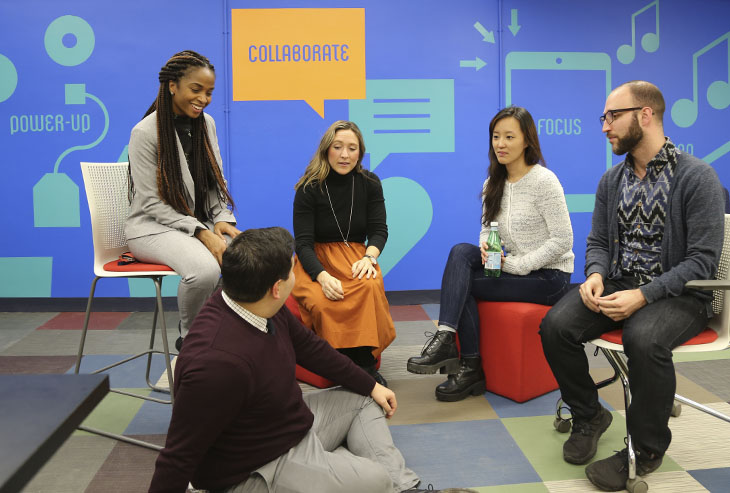Teachers spend countless hours creating an environment for students to thrive in. Students are not the only ones who benefit from a supportive school culture. As lifelong learners, teachers need spaces to develop too. The teachers at Grant Avenue School in New York recognized this, but with 464 students and a busy schedule, there was little space for opportunities to learn from each other. Fortunately, there was 500 square feet of underutilized space in an old science storage room. The room was transformed from storing books and science equipment to become an active hub where colleagues share ideas and experiences.
The transformation began when the not-for-profit organization Change for Kids connected with Hillmann Consulting and Gensler to create a place for the teachers to call their own. The organization was already working with the teachers to maintain a strong culture. The project was familiar territory for the design team. Through initiatives like EDU 2.0 and Community Impact, Gensler supports not-for-profit institutions with volunteer activities, pro-bono projects, mentorship, and other activities that give back to the community.
The teachers’ dedication was clear from the beginning when they shared their experience in a visioning session. Their mission is to create the best setting for their students—no matter the time and energy it takes. A community of empowered educators translates to inspired students in the classroom. Research shows motivation plays a critical role in guiding the direction and quality of learning behaviors in students. (How Learning Works, S. Ambrose). The space simultaneously benefits teachers and students.
 Image © Gensler.
Image © Gensler.
Known as the Teacher coLab, the rejuvenated space takes inspiration from academic incubators in higher education. The programming elements are just as applicable in an elementary school setting. Collaborative spaces like this help educators come together to share knowledge and enhance their skills. The multifunctional space facilitates think tanks, coworking areas, and acts as a forum for knowledge exchange between colleagues.
 Image © Gensler.
Image © Gensler.
The design supports teachers throughout their day in four zones. Each functions for a specific behavior in the program. The “Power Up” zone offers a pantry to connect around with colleagues. The “Collaborate” zone provides tables and writable surfaces for meetings and team-based learning. The “Focus” zone helps teachers reflect and have time to themselves. The “Unwind” zone is a living-room style space where teachers engage in thought-provoking conversations in a more relaxed environment.
It is important to combine school spirit and comfort in teacher-centered spaces. The space features bright accent colors and engaging brand elements to offer a respite from the loud corridors and busy classrooms. Today, Grant Avenue teachers power up before the first bell rings, exchange ideas with colleagues, complete lesson plans, and relax—all in one place.
Small interventions and dedicated programming better prepare schools to have a positive experience for both students and teachers. Designers may provide guidelines on how to use the room, but in the end, teachers make the space their own to bring new ideas back into the classroom.
More from Author
Gensler | Oct 21, 2024
3 surprises impacting the return to the office
This blog series exploring Gensler's Workplace Survey shows the top three surprises uncovered in the return to the office.
Gensler | Jun 26, 2024
5 ways ESG can influence design and create opportunities
Gensler sustainability leaders Stacey Olson, Anthony Brower, and Audrey Handelman share five ways they're rethinking designing for ESG, using a science-based approach that can impact the ESG value chain.
Gensler | May 20, 2024
10 spaces that are no longer optional to create a great workplace
Amenities are no longer optional. The new role of the office is not only a place to get work done, but to provide a mix of work experiences for employees.
Gensler | Apr 15, 2024
3 ways the most innovative companies work differently
Gensler’s pre-pandemic workplace research reinforced that great workplace design drives creativity and innovation. Using six performance indicators, we're able to view workers’ perceptions of the quality of innovation, creativity, and leadership in an employee’s organization.
Gensler | Mar 13, 2024
Trends to watch shaping the future of ESG
Gensler’s Climate Action & Sustainability Services Leaders Anthony Brower, Juliette Morgan, and Kirsten Ritchie discuss trends shaping the future of environmental, social, and governance (ESG).
Gensler | Feb 15, 2024
5 things developers should know about mass timber
Gensler's Erik Barth, architect and regional design resilience leader, shares considerations for developers when looking at mass timber solutions.
Gensler | Jan 15, 2024
How to keep airports functional during construction
Gensler's aviation experts share new ideas about how to make the airport construction process better moving forward.
Gensler | Dec 18, 2023
The impacts of affordability, remote work, and personal safety on urban life
Data from Gensler's City Pulse Survey shows that although people are satisfied with their city's experience, it may not be enough.
Gensler | Nov 16, 2023
How inclusive design supports resilience and climate preparedness
Gail Napell, AIA, LEED AP BD+C, shares five tips and examples of inclusive design across a variety of building sectors.
Gensler | Oct 16, 2023
The impact of office-to-residential conversion on downtown areas
Gensler's Duanne Render looks at the incentives that could bring more office-to-residential conversions to life.
















